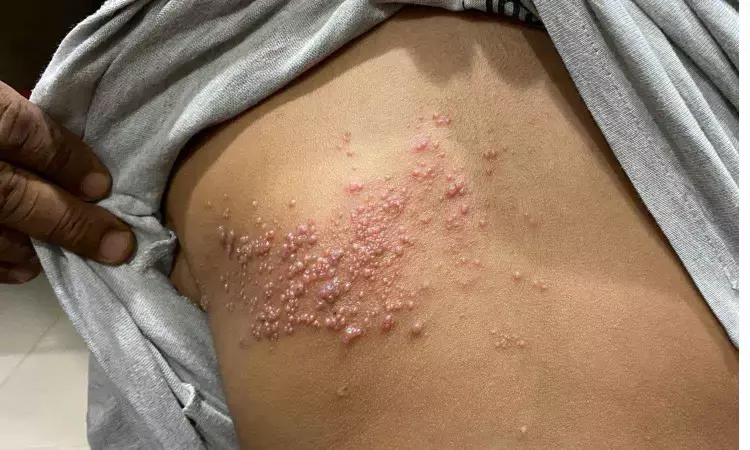- Home
- Medical news & Guidelines
- Anesthesiology
- Cardiology and CTVS
- Critical Care
- Dentistry
- Dermatology
- Diabetes and Endocrinology
- ENT
- Gastroenterology
- Medicine
- Nephrology
- Neurology
- Obstretics-Gynaecology
- Oncology
- Ophthalmology
- Orthopaedics
- Pediatrics-Neonatology
- Psychiatry
- Pulmonology
- Radiology
- Surgery
- Urology
- Laboratory Medicine
- Diet
- Nursing
- Paramedical
- Physiotherapy
- Health news
- Fact Check
- Bone Health Fact Check
- Brain Health Fact Check
- Cancer Related Fact Check
- Child Care Fact Check
- Dental and oral health fact check
- Diabetes and metabolic health fact check
- Diet and Nutrition Fact Check
- Eye and ENT Care Fact Check
- Fitness fact check
- Gut health fact check
- Heart health fact check
- Kidney health fact check
- Medical education fact check
- Men's health fact check
- Respiratory fact check
- Skin and hair care fact check
- Vaccine and Immunization fact check
- Women's health fact check
- AYUSH
- State News
- Andaman and Nicobar Islands
- Andhra Pradesh
- Arunachal Pradesh
- Assam
- Bihar
- Chandigarh
- Chattisgarh
- Dadra and Nagar Haveli
- Daman and Diu
- Delhi
- Goa
- Gujarat
- Haryana
- Himachal Pradesh
- Jammu & Kashmir
- Jharkhand
- Karnataka
- Kerala
- Ladakh
- Lakshadweep
- Madhya Pradesh
- Maharashtra
- Manipur
- Meghalaya
- Mizoram
- Nagaland
- Odisha
- Puducherry
- Punjab
- Rajasthan
- Sikkim
- Tamil Nadu
- Telangana
- Tripura
- Uttar Pradesh
- Uttrakhand
- West Bengal
- Medical Education
- Industry
Crisugabalin Shows Significant Pain Reduction in Postherpetic Neuralgia Patients: Study

Researchers found that the novel oral calcium channel subunit ligand crisugabalin significantly reduced pain in patients experiencing postherpetic neuralgia. Postherpetic neuralgia is considered one of the most painful herpes zoster complications and is a significant public health concern in the country. Current treatments, including pregabalin and gabapentin, often fail to provide complete efficacy and have side effects that preclude using them optimally. A new study was published in the journal JAMA Dermatology by Daying Zhang and colleagues.
To ascertain the efficacy and safety of crisugabalin in treating postherpetic neuralgia, this randomized clinical trial was performed from November 2021 through January 2023 at 48 tertiary care centers in China. It was a two-arm clinical study: first, a double-blind phase for 12 weeks and an open-label extension for 14 weeks. This comprised 366 adult patients with postherpetic neuralgia with an average daily pain score of at least 4 on the Numeric Pain Rating Scale (0-10) over the week preceding study entry. Patients who failed to respond to high doses of pregabalin ≥300 mg/d or gabapentin ≥1200 mg/d were excluded.
Participants were randomly assigned in a 1:1:1 ratio to crisugabalin 40 mg/d (20 mg twice daily), crisugabalin 80 mg/d (40 mg twice daily), or placebo. All participants completed the 2-week screening period, followed by the 7-day run-in phase and then treatment for 12 weeks.
The average daily pain score (ADPS) change from baseline to week 12 was the primary efficacy endpoint. The results were deemed clinically significant reductions in pain for both of the dosage groups taking crisugabalin compared with the placebo group:
• For patients in the 40 mg/d dosage group of crisugabalin, the least squares mean change in ADPS was −2.2 (SD 0.2).
• Least squares mean change in ADPS showed marked decreases in patients taking crisugabalin at 80 mg/d by an even greater amount of −2.6 (SD 0.2).
• Placebo group: mean change in ADPS was −1.1 (SD 0.2).
• LS Mean difference between crisugabalin 40 mg/d and placebo was −1.1 (95% CI, −1.6 to −0.7; P < 0.001), and between crisugabalin 80 mg/d and placebo was −1.5 (95% CI, −2.0 to −1.0; P < 0.001).
No new safety issues emerged during the 12 weeks of double-blind treatment. Side effects were generally similar between treatment groups and placebo. All extensions of the trial in an open-label manner further served to confirm that the drug was safe, since all patients continuing received crisugabalin 40 mg twice daily and no significant safety issues developed.
Overall, crisugabalin at a dose of 40 mg/d or 80 mg/d resulted in statistically significant improvements in pain reduction in patients suffering from postherpetic neuralgia. These results imply that crisugabalin can be one useful new alternative to treating patients diagnosed with postherpetic neuralgia when they look for other options besides traditional calcium channel ligands such as pregabalin or gabapentin.
Reference:
Zhang, D., Lei, T., Qin, L., Li, C., Lin, X., Wang, H., Zhang, G., Zhang, S., Shi, K., Li, L., Yang, Z., Yang, X., Ba, X., Gao, Y., Zhang, Z., Wang, G., Wu, L., Wang, Y., Wang, Y., … Lu, Q. (2024). Efficacy and safety of crisugabalin (HSK16149) in adults with postherpetic neuralgia: A phase 3 randomized clinical trial. JAMA Dermatology (Chicago, Ill.). https://doi.org/10.1001/jamadermatol.2024.3410
Dr Riya Dave has completed dentistry from Gujarat University in 2022. She is a dentist and accomplished medical and scientific writer known for her commitment to bridging the gap between clinical expertise and accessible healthcare information. She has been actively involved in writing blogs related to health and wellness.
Dr Kamal Kant Kohli-MBBS, DTCD- a chest specialist with more than 30 years of practice and a flair for writing clinical articles, Dr Kamal Kant Kohli joined Medical Dialogues as a Chief Editor of Medical News. Besides writing articles, as an editor, he proofreads and verifies all the medical content published on Medical Dialogues including those coming from journals, studies,medical conferences,guidelines etc. Email: drkohli@medicaldialogues.in. Contact no. 011-43720751


